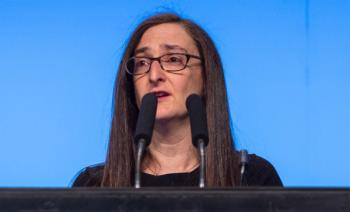
Duvelisib improved the median progression-free survival of patients with chronic lymphocytic leukemia/small lymphocytic lymphoma by about 3.5 months compared with the current standard, ofatumumab.

Your AI-Trained Oncology Knowledge Connection!


Duvelisib improved the median progression-free survival of patients with chronic lymphocytic leukemia/small lymphocytic lymphoma by about 3.5 months compared with the current standard, ofatumumab.

PD-L1 expression was more common among patients with the GCB subtype of diffuse large B-cell lymphoma, and PD-L1 positivity predicted shorter survival.

A new study has shown several ways that the health-related quality of life in cancer patients older than 65 years could be improved.

Treatment with carfilzomib for multiple myeloma was associated with increased incidence of cardiovascular adverse events, especially with higher doses.

Continuous treatment with lenalidomide/dexamethasone significantly improved survival in patients with transplant-ineligible newly diagnosed multiple myeloma.

The FDA has granted priority review to the combination of dabrafenib (Tafinlar) and trametinib (Mekinist) for the adjuvant treatment of patients with stage III melanoma with BRAF V600E or V600K mutations after complete disease resection.

The FDA has expanded the label for cabozantinib (Cabometyx) to include first-line treatment of advanced renal cell carcinoma regardless of treatment status. Cabozantinib was initially approved in patients who had previously received anti-angiogenic therapy.

Experience with the recently enacted California End of Life Option Act has shown that a high percentage of patients who requested aid-in-dying drugs in California have proceeded with ingesting the drugs. The majority of these requests were made by terminal cancer patients.

The FDA has approved nivolumab for the adjuvant treatment of melanoma; it showed superiority compared with the standard of care in this patient population.

Early disease progression for chronic lymphocytic leukemia was a robust prognostic factor for worse overall survival in patients treated with chemoimmunotherapy.

Venetoclax has durable clinical activity in patients with relapsed/refractory chronic lymphocytic leukemia whose disease progressed during or after ibrutinib therapy.

Use of a brief educational video increased hairdressers’ knowledge of melanoma detection and improved their self-confidence to detect skin lesions.

The addition of tumor-treating fields to maintenance temozolomide chemotherapy significantly delayed progression and improved overall survival in patients with glioblastoma who had received standard radiochemotherapy compared with maintenance temozolomide alone.

CAR T cells targeting CD19 can be effective at treating relapsed/refractory diffuse large B-cell lymphoma or follicular lymphoma, with high rates of durable remission.

A new study has found that there are significant gaps in participation among people aged 75 and older in clinical trials of hematologic malignancies when considered against the incidence of these malignancies in this age group.

History of Epstein-Barr virus or immunosuppression did not affect outcomes for patients with diffuse large B-cell lymphoma.

Undergoing axillary lymph node dissection is associated with increased arm morbidity in younger breast cancer patients compared with sentinel lymph node biopsy.

Patients with gastrointestinal neuroendocrine tumors with carcinoid syndrome are more than twice as likely to have certain pre-existing diagnoses compared with patients without carcinoid syndrome, according to the results of a study.

Post-traumatic stress disorder may be persistent or worsening in patients with cancer up to 4 years after an initial diagnosis of the disorder, according to the results of a study.

A single treatment with a second-generation CAR T-cell treatment elicited an overall response rate of 94% in a small study of patients with heavily pretreated multiple myeloma, according to the results of a phase I study presented at the ASH Annual Meeting.

Patients with Hodgkin lymphoma treated with a drug combination including brentuximab vedotin achieved superior progression-free survival, with a reduction in the risk for progression, death, or need for additional anticancer therapy, compared with the standard four-drug chemotherapy regimen.

About one-third of patients with previously treated chronic lymphocytic leukemia (CLL) were minimal residual disease negative after 6 months of treatment with the combination of targeted agents ibrutinib and venetoclax, according to the results of the TAP CLARITY study.

Hospice use occurred more frequently among Medicare beneficiaries with acute and chronic leukemias who were transfusion dependent, according to the results of a study presented at the ASH Annual Meeting.

Disease-free survival after 9 weeks of adjuvant trastuzumab and standard chemotherapy was not comparable to disease-free survival after 1 year of adjuvant trastuzumab and standard chemotherapy for women with early-stage HER2-positive breast cancer.

After undergoing 5 years of adjuvant endocrine therapy, 2 years of extended anastrozole proved as effective as 5 years for preventing breast cancer recurrence among postmenopausal women with hormone receptor (HR)-positive breast cancer, according to the results of the ABCSG-16 phase III trial.

Treatment with gonadotropin-releasing hormone analog can safely and effectively protect ovarian function and has the potential to preserve fertility in premenopausal women undergoing chemotherapy for early-stage breast cancer.

Undergoing acupuncture significantly reduced joint pain related to treatment with aromatase inhibitors in postmenopausal women with early-stage breast cancer.

Although a longer progression-free survival is of high importance to CLL patients, a reduced risk of serious adverse events might be worth a tradeoff for some efficacy.

The FDA approved a biosimilar for trastuzumab, Ogivri, for the treatment of patients with HER2-positive breast and stomach cancer.

Treatment with crizotinib resulted in objective responses in patients with advanced papillary renal cell carcinoma type 1 with MET mutations or amplification.